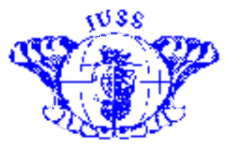


Integrated Undersea Surveillance System (IUSS)
 The Integrated Undersea Surveillance System (IUSS) is comprised of fixed, mobile, and deployable acoustic arrays that provide vital tactical cueing to ASW forces. IUSS
provides the Navy with its primary means of submarine detection both
nuclear and diesel.
The Integrated Undersea Surveillance System (IUSS) is comprised of fixed, mobile, and deployable acoustic arrays that provide vital tactical cueing to ASW forces. IUSS
provides the Navy with its primary means of submarine detection both
nuclear and diesel.
With the advent of submarine warfare and it's impact on Allied forces and supply
lines in WWII, the need for timely detection of undersea threats was made a high
priority in Anti-Submarine Warfare (ASW). As technology of the time progressed, it
was recognized that shore-based monitoring stations were the answer to the problem
since they could be made basically impervious to destruction, foul weather, and
ambient self-generated noise. Since the early 1950s the Atlantic and Pacific oceans
have been under the vigilence of the Sound Surveillance System (SOSUS), with long
acoustic sensors (hydrophones) installed across the ocean bottom at key locations.
With the development of quieter submarines and counter-tactics to evade SOSUS,
newer technologies have been implemented over the years to "keep up with the
threat". Faster processors, higher capacity storage devices, and "cleaner code" has
enabled the advancement of the art of locating undersea threats. Currently, the
Integrated Undersea Surveillance System (IUSS) uses all of these advancements in
the Fixed Surveillance System (FSS), Fixed Distributed System (FDS), and the
Advanced Deployable System (ADS).
The program has undergone a major transition from emphasis on maintaining a large dispersed surveillance force keyed to detection and tracking of Soviet submarines to a much smaller force
that is effective against modern diesel and nuclear submarines in regional/littoral or broad ocean areas of interest. Work stations, enhanced signal processing, and modern communication technologies enable remote array monitoring, which reduces manpower costs and improves efficiency.
Under operational command of the U.S. Navy's Commander Undersea Surveillance
(CUS) IUSS shore systems are staffed and operated by uniformed U.S. Navy
personnel. System life cycle and engineering support is provided by carreer civil
servants (NISE East Code 341) and contractor personnel located at the IUSS
Operations Support Center (IOSC).
NRaD provides software maintenance support for IUSS field subsystems. In CY 94, NRaD successfully completed testing of the IUSS Block 3 software in NRaD's Surveillance Test and Integration Center (STIC). The operational demonstration of SPOTLIGHT at the Dam Neck Validation Center (DSVC) began on 1 December with operator training, with the demonstration continuing through the month. The SPOTLIGHT ATD successfully concluded with this demonstration, and transition of the technology is scheduled for implementation in the Surveillance Direction System.
The deployment and maintenance of the undersea components of the IUSS shore
systems is accomplished by technicians and engineers operating from IUSS Cable
Support Ships.
Sources and Methods
http://www.fas.org/irp/program/collect/iuss.htm
Created by John Pike
Maintained by Steven Aftergood
Updated Saturday, June 21, 1997 11:14:49 AM
 The Integrated Undersea Surveillance System (IUSS) is comprised of fixed, mobile, and deployable acoustic arrays that provide vital tactical cueing to ASW forces. IUSS
provides the Navy with its primary means of submarine detection both
nuclear and diesel.
The Integrated Undersea Surveillance System (IUSS) is comprised of fixed, mobile, and deployable acoustic arrays that provide vital tactical cueing to ASW forces. IUSS
provides the Navy with its primary means of submarine detection both
nuclear and diesel.


